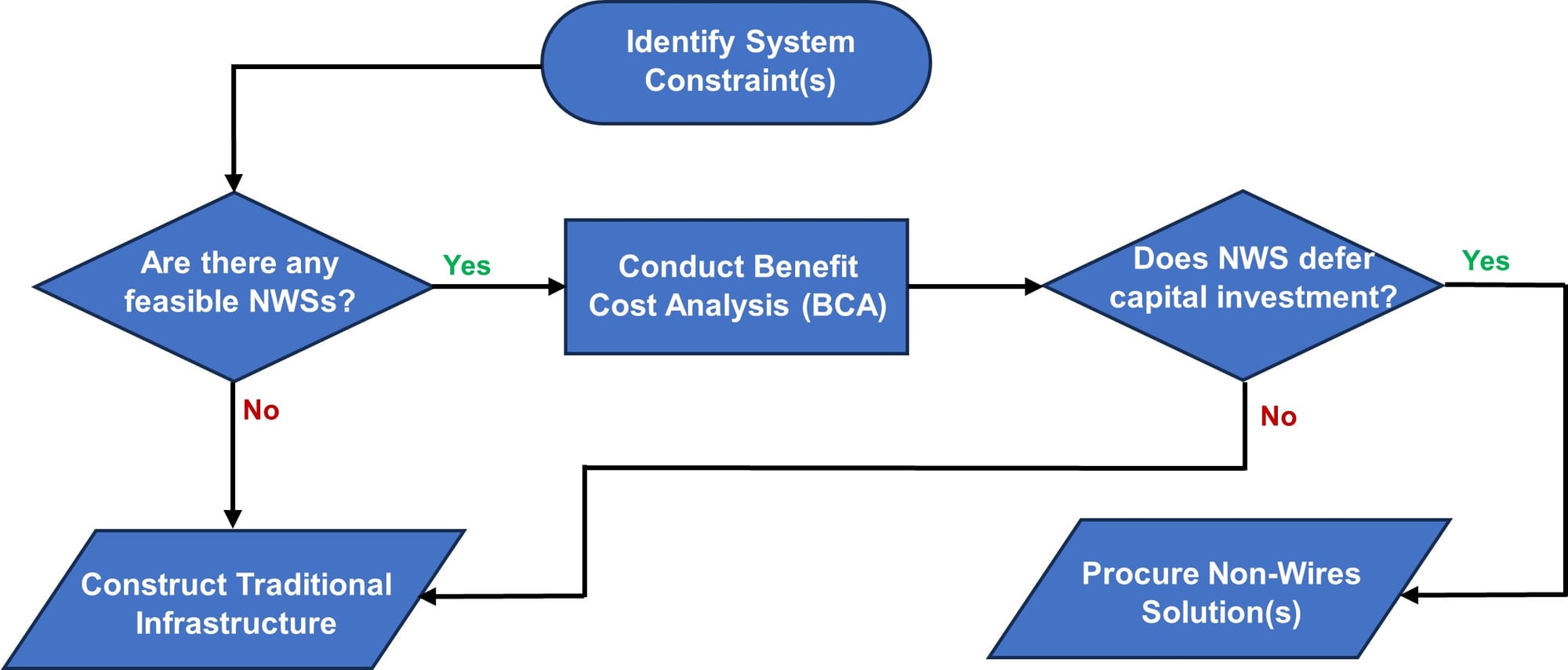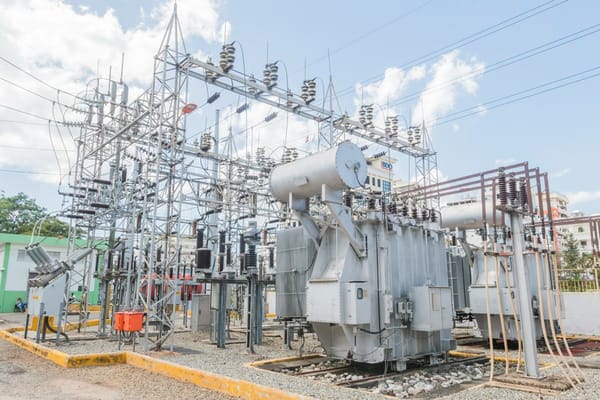Deferring Infrastructure Investments with Non-Wires Solutions
For years, utilities have relied on infrastructure-heavy approaches to handle grid stress. Now they're turning to Non-Wire Solutions to bridge the gap.

In March 2024, the Ontario Energy Regulator, the Ontario Energy Board (OEB) issued the Non-Wires Solutions Guidelines for Electricity Distributors (NWS Guidelines). The NWS Guidelines replace the Conservation and Demand Management Guidelines (CDM Guidelines), issued in 2021, reflecting the fact that Non-Wires Solutions (NWSs) can include options like distributed generation and storage along with more traditional CDM measures.
A key change from the CDM Guidelines is that the NWS Guidelines establish a new requirement for distributors to document their consideration of NWSs when making investment decisions on electricity system needs with an expected capital cost of $2 million or more as part of distribution system planning. This excludes general plant investments.
This blog kicks off a series on how utilities can leverage NWSs to optimize their infrastructure planning. Today, we’ll explore how NWSs can help utilities defer infrastructure investments, particularly by addressing challenges with constrained or overloaded feeders.
Picture this: A utility is facing a critical issue with several of its distribution feeders that are nearing their capacity limits. Traditionally, the solution would involve costly upgrades—replacing or reinforcing distribution lines, installing larger transformers, or even building new substations. These upgrades, while effective, take time and significant capital investment. But what if there was a more agile way to address these constraints? Drum Roll …. enter NWSs.
For years, utilities have relied on infrastructure-heavy approaches to handle grid stress, such as overloaded feeders. However, as the energy landscape evolves, Distributed Energy Resources (DERs) offer new possibilities for solving these problems without expanding physical infrastructure.
What Are Non-Wires Solutions?

In traditional utility planning, load growth almost always resulted in new physical assets—additional transformers, new distribution lines, and larger substations. These infrastructure projects were designed to ensure the grid could handle peak demand periods but came with hefty price tags and long lead times.
NWSs flip that script. Instead of always investing in physical infrastructure, utilities can now tap into DERs—resources like rooftop solar, battery storage, and demand-side interventions—to manage growth. It’s like managing traffic congestion by encouraging public transportation and carpooling rather than simply building more lanes on a highway. These flexible, distributed solutions provide immediate relief and can be scaled or adapted as needs evolve.
In cases where feeders are overloaded, NWSs can provide immediate relief. For example, strategically placed energy storage can absorb excess energy during low demand periods and discharge it during peak times, relieving stress on the grid. Similarly, Demand Response programs encourage customers to reduce their consumption during peak periods, keeping the feeders within capacity.
Why Should Utilities Consider NWSs?
NWSs offer utilities the flexibility to manage grid constraints without large capital expenditures, providing not only cost savings but also environmental benefits by promoting the use of renewable energy and customer engagement.
1. Capital Deferral: By using NWSs to manage load, utilities can defer or avoid costly investments in distribution infrastructure, freeing up capital for other critical projects.
2. Environmental Benefits: Many DERs, especially those involving renewable energy sources and storage, contribute to reduced carbon emissions. This aligns with broader sustainability goals and regulatory mandates.
3. Customer Engagement: NWSs, particularly through Demand Response and Energy Efficiency programs, involve active participation from customers, creating a more engaged and loyal customer base. This interaction allows utilities to strengthen their relationships with both residential and commercial customers.
4. Regulatory Incentives: Regulatory bodies like the OEB are encouraging the use of NWSs to defer infrastructure upgrades. The OEB’s Non-Wires Solutions Guidelines and BCA Framework provide a structured approach for evaluating the economic viability of these alternatives, helping utilities to justify their use in distribution system planning.
How Non-Wires Solutions Defer Infrastructure Investments

The ability to defer or avoid traditional infrastructure investments is one of the most compelling benefits of NWSs. Utilities are under increasing pressure to manage aging infrastructure, integrate renewable energy, and handle shifting demand patterns, all while controlling costs. NWSs provide a way to meet these needs without immediately resorting to expensive, long-term capital projects.
Cost-Benefit Analysis of NWS vs. Traditional Infrastructure
When considering the financial implications of NWSs, the key advantage is in their ability to defer capital investment while delivering comparable grid services. This is where Benefit-Cost Analysis (BCA) plays a crucial role. The BCA framework, as outlined by the OEB, helps utilities evaluate whether NWS can meet system needs more efficiently than traditional infrastructure investments.
· Scenario Analysis: Utilities can run scenarios comparing the upfront capital costs of building a new substation with the potential savings from implementing a combination of DERs, demand response, and energy storage.
· Lifecycle Costs: NWS often have lower operating and maintenance costs compared to traditional infrastructure, which requires continuous investment in upgrades and repairs.
We will be discussing the OEB’s BCA framework in greater detail in our next blog post.
Operational Flexibility
Unlike traditional infrastructure, which is relatively inflexible once installed, NWSs offer operational flexibility. For instance, a battery storage system can be deployed in a matter of months, compared to the years it might take to construct a new substation. Furthermore, NWSs can be quickly adapted as grid conditions change.
Regulatory and Financial Benefits of NWS

One of the key enablers for the adoption of Non-Wires Solutions is the growing regulatory support and the financial benefits they offer to utilities. Regulators like the OEB are recognizing the potential of NWSs to defer capital investments and improve grid flexibility.
Regulatory Support for NWSs
The OEB’s NWS Guidelines encourage utilities to explore and implement NWSs before defaulting to traditional infrastructure investments. These guidelines outline how utilities can integrate DERs into their planning processes and submit NWSs as part of their rate applications. Utilities that align with these regulatory frameworks can secure approval for NWS projects more efficiently, ensuring timely implementation.
Additionally, the BCA Framework provides utilities with a structured approach to evaluate the economic feasibility of NWS. This framework helps justify NWSs as viable alternatives to infrastructure projects by comparing their long-term costs and benefits, factoring in operational savings, and customer value.
Financial Benefits of NWSs
NWSs can provide utilities with significant financial benefits, particularly in terms of reducing operating costs. By deferring or avoiding large-scale infrastructure investments, utilities can lower ongoing maintenance expenses, which translates into fewer rate increases for consumers. This cost efficiency allows utilities to operate with more financial flexibility, while still maintaining reliable service.
Moreover, while utilities might not be able to directly own DERs, third-party DER owners can earn revenue through potentially participating in electricity markets, creating additional incentives for the deployment of distributed energy resources. This not only enhances grid flexibility but also fosters collaboration between utilities and DER providers, contributing to a more resilient and adaptive energy system.
Enhancing Grid Reliability and Resilience with NWSs

Non-Wires Solutions don’t just provide financial and operational benefits; they also play a critical role in enhancing grid reliability and resilience. As weather patterns become more unpredictable and the grid faces increased stress from extreme events, NWSs offer a way to build a more adaptable, resilient system.
Improving Reliability Through Distributed Resources
With DERs spread across the grid, utilities can reduce their reliance on centralized infrastructure, which can act as a single point of failure leading to larger outages. For example, energy storage systems can act as localized backup power during outages, ensuring that critical loads are maintained even when parts of the grid are down. Similarly, Distributed Generation sources like solar PV and wind can provide electricity directly to local areas, reducing the load on long-distance distribution lines and improving overall system reliability.
Enhancing Resilience in the Face of Disasters
Extreme weather events such as ice storms, heatwaves, or hurricanes can have devastating effects on centralized grid infrastructure. NWSs help utilities build resilience by creating more localized, flexible power sources. By distributing generation and storage assets across the network, utilities can reduce the impact of localized failures and recover more quickly from outages.
Incorporating Demand-Side Management also plays a key role in resilience. Demand Response programs can be activated during emergencies to reduce load quickly, preventing the grid from becoming overloaded during critical times.
Conclusion
Non-Wires Solutions (NWSs) can represent a cost-effective and practical approach for utilities looking to address system needs while deferring costly infrastructure investments. By leveraging Distributed Energy Resources (DERs)—including distributed generation, energy storage, and demand-side management—utilities can tackle issues like overloaded feeders, reduce operating costs, and improve grid flexibility. The regulatory landscape, especially in Ontario, is evolving to support these innovative solutions, offering utilities a framework to assess and implement NWS effectively.
As the energy landscape continues to shift, embracing NWSs provides utilities with the tools to stay agile, environmentally responsible, and financially prudent. The ability to defer infrastructure investments not only reduces the burden on capital budgets but also translates into fewer rate increases for consumers. Additionally, NWSs open revenue opportunities for third-party DER owners, fostering a more decentralized and resilient grid.
Now is the time for utilities to explore the full potential of Non-Wires Solutions in their planning processes. If you’re ready to explore how NWSs might benefit your utility, contact our team for expert guidance. We can help you develop tailored NWSs roadmaps, perform Benefit-Cost Analysis (BCA), and create strategies that align with both regulatory frameworks and operational goals. Together, we can build a more flexible, sustainable, and cost-effective future for your utility.
In the following posts of this series, we’ll explore the critical role of Benefit-Cost Analysis (BCA) in evaluating the viability of NWSs, and how utilities can integrate DERs as part of their NWSs strategies. Stay tuned as we dive deeper into these game-changing approaches.





